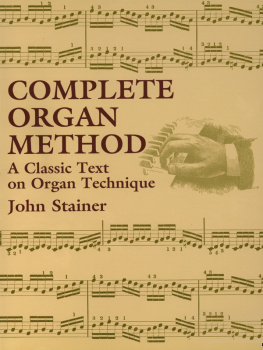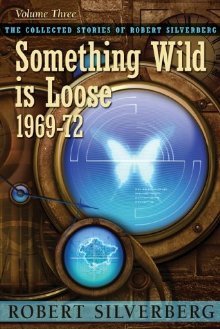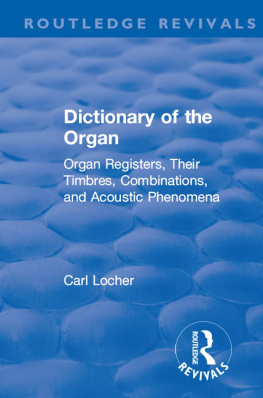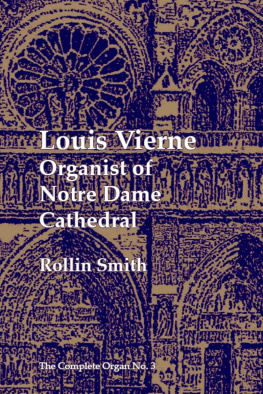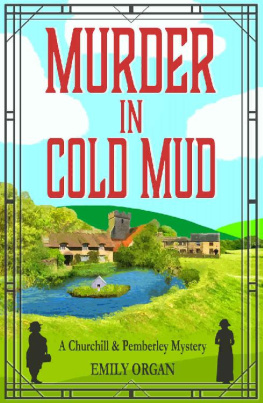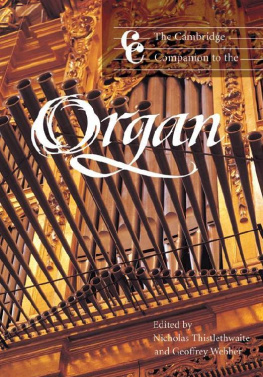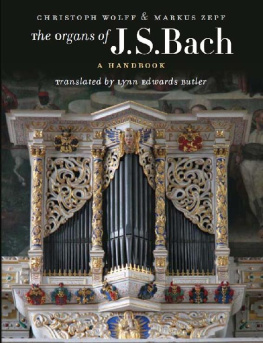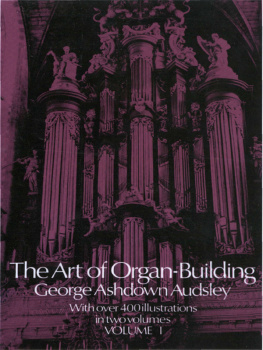C OMPLETE O RGAN M ETHOD
John Stainer
Edited by
F. FLAXINGTON HARKER
Introduction by
ROLLIN SMITH
DOVER PUBLICATIONS, INC.
Mineola, New York
Copyright
Copyright 2003 by Dover Publications, Inc.
All rights reserved.
Bibliographical Note
This Dover edition, first published in 2003, is a slightly enlarged republication of The Organ by John Stainer / A new edition critically revised , with numerous addenda, and adapted to the requirements of both pneumatic and electric actions by F. Flaxington Harker, originally published by G. Schirmer, New York, 1909.
Rollin Smiths Introduction to the Dover Edition and newly added organ music by Bach and Mendelssohn complete this publication.
International Standard Book Number
ISBN-13: 978-0-486-43079-9
ISBN-10: 0-486-43079-0
Manufactured in the United States by Courier Corporation
43079003
www.doverpublications.com
INTRODUCTION TO THE DOVER EDITION
___________________
T HIS organ primer-written by eminent organist, musicologist, and composer Sir John Stainer-was ubiquitous throughout the English-speaking world for almost a century. Published in 1877, it has seen few rivals in building a firm technical foundation for the beginning organist.
Born in 1840, Stainer was blessed from his youth with a home submerged in music. In a house containing no fewer than five pianos and a small chamber organ, his father taught his six children to play. Eldest daughter Annie held the position as organist of the Magdalen Hospital Chapel, Streatham, for half a centuryand young John progressed so remarkably that at age seven he could play a Bach fugue as well as an organ transcription of the overture to Handels Acis and Galatea . A year later, John entered the choir of St. Pauls Cathedral and was soon one of the leading boy soloists. While still a chorister, he became organist of St. Benedict and St. Peter, Pauls Wharf; his progress was so great that at sixteen he was given the post of organist at the College of St. Michael, Tenbury. Stainer went on to receive the Doctor of Music degree from Christ Church, Oxford, in 1865. In 1872, he succeeded Sir John Goss as organist of Londons St. Pauls Cathedral.
Devoted to musical activities that extended far beyond church duties, Stainer was a founder and president of the Musical Association, professor of music at Oxford, vice-president of the Royal College of Organists, and later president of both the Plainsong and Medieval Music Society and the London Gregorian Association. He is remembered today as a pioneer of English musicology, and his edition of Early Bodleian Music was the first significant investigation of Renaissance music by an English musicologist. Knighted in 1888 (the year he resigned his post at St. Pauls due to failing eyesight), Stainer died in Verona, Italy, on 31 March 1901, during a trip abroad.
Composer of three oratorios, three cantatas, twelve Anglican services, 150 hymn tunes and numerous anthems, organ works, and miscellaneous vocal music, Stainers Sevenfold Amen is still
heard in church services throughout England. His most famous work is the oratorio The Crucifixion (1887) from which the chorus God So Loved the World has remained a staple of the choral repertoire.
___________________
Since full-compass pedalboards were scarce in England before the 1870s, Stainers comprehensive organ method was relatively novel at the time of its publication in 1877. W. T. Bests The Art of Organ Playing had appeared two years earlier, and its advanced treatment of technical issues may have suggested to Stainer the need for a more rudimentary tutor. In a short time, however, Sir Johns The Organ became the classic beginners method-so popular that in the early years of the twentieth century American publishers Schirmer, Ditson, and Presser each issued its own edition. An American edition was necessary because the original publication used the fingering system then prevalent in England: the thumb was indicated by letter x, the index finger by number 1.
Before addressing actual organ playing, Stainer provides a brief history of the instrument followed by an explanation of organ construction. Thenfollowing the examples of Jonas Blewitt in his Treatise on the Organ (1795) and Bests Modern School for the Organ (1853)Stainer provides a detailed discussion of the various stops and their management. The major portion of The Organ is devoted to practical study. With the authors meticulous explanations and accompanying illustrations, the student can actually teach himself to play.
In this important and highly accessible book, Stainers objective was to place the true principles of organ playing before the beginner to the end that the student would face at once the special difficulties of the instrument and persevere until they were surmounted. The instruments principal variation from the piano is, of course, the pedalboard, and the author goes into pedal technique in detail, from the kind of shoe to wear to finding the notes without looking! After addressing precision in manual touch, he then begins to work on the students independence between hands and feet-the most difficult aspect of organ playing for the beginner. Pedal scales, trios, and finger substitution to achieve a perfect legato are followed by directions for hymn playing. Seven organ pieces complete the original edition, including five of Stainers own works and two pieces by Guilmant; three additional works have been added to round out this Dover edition.
R OLLIN S MITH
S PRING 2003
___________________________
T HERE are two ways in which time may be devoted to the practice of a musical instrument. The first and most common is, to avoid the difficulties which present themselves, and to be content with mastering just so much of the art of playing as will afford a little amusement; the other is, to face at once the special difficulties of the instrument and persevere until they are surmounted. By the former, a player cannot possibly rise above a very mediocre standard, and his performance will never receive higher praise than that of being called tolerable; but by the latter, the highest excellence will be within reach, and the student will be limited in its attainment only by the amount of natural talents with which he may be endowed.
Perhaps no instrument offers such a temptation to triflers as the Organ, for the obvious reason that an immense variety of tone can be produced on it by merely mechanical means. Hence it is of the utmost importance that the student should take his first steps in the right direction. The Author has endeavored to place the true principles of organ-playing before the beginner, and he hopes he has done so in a manner not uninteresting or discouraging.
He takes this opportunity of acknowledging his obligations to the eminent organ-builder, Mr. Henry Willis, for much valuable assistance.
___________________
W ITH the exception of a few minor details the work of Sir John Stainer remains the same. The new material in Parts I and II comprises the development of the Pneumatic and Electric Actions, with drawings from Key to Pallet, and, as far as possible, the latest inventions have been described.
In Part III little has been done except the grouping of 4-foot and 2-foot stops under the correct heading of Foundation stops, and, where stops are known by two different names, the old and the new terms are given for completeness.
A list of stops for the Solo and Echo or Celestial Organs, with the character of tone of each stop, together with a complete list of Couplers to be found on Modern Organs, have been added. The section Hints on Organ Accompaniment for the church service is not intended to be a complete guide to this important subject, but to serve merely as an introduction to a fascinating and almost endless study.
Next page
